Bornella japonica
Baba, 1949
Order: NUDIBRANCHIA
Suborder: DENDRONOTINA
Family: Bornellidae
DISTRIBUTION
Known only from Japan
PHOTO
If anyone has photos of a Bornella with only 3 pairs of dorsolateral processes [cerata] then it could possibly be this species. If so, I would love to see them. ... Bill Rudman
I am not sure if this is a distinct species or not. In Baba's description he says it is of similar size and colour to Bornella stellifer [as B. digitata] but that it is easily distinguished by the following characters:
• Rhinophore sheaths with 4 supra-marginal papillae, the hindmost and largest subdivided into 2-3 smaller papillae. [In B. stellifer the supra-marginal papillae are simple].
• Dorso-lateral processes in 3 pairs, [6 pairs in B. stellifer].
• Shape of radular teeth similar in both species but formula of B. japonica is 35 x 14.1.14, and of B. stellifer 32x 7[or 8].1. 7[or 8].
Baba mentions other differences in the shape of the dorso-lateral processes ('cerata') but they are not clear in his illustrations. It is possible a photo in Kieu Suzuki's book [no 195, p 130 - identified as B. digitata] could be this species but I am not sure.
Reference:
• Baba, K. (1949) Opisthobranchia of Sagami Bay collected by His Majesty, the Emperor of Japan. Iwanami Shoten, Tokyo.
Rudman, W.B., 2001 (September 3) Bornella japonica Baba, 1949. [In] Sea Slug Forum. Australian Museum, Sydney. Available from http://www.seaslugforum.net/find/bornjapo
Related messages
Bornella japonica? from the Marshall Islands
May 25, 2007
From: Scott Johnson
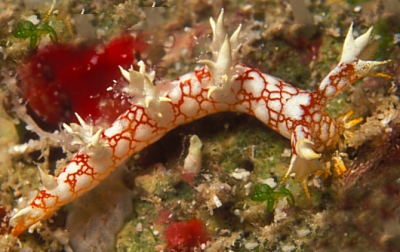
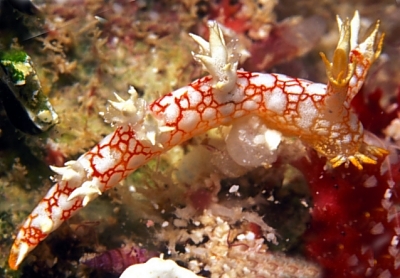
Hi Bill,
I have been slowly putting photos of the opisthobranchs of the Marshalls on my web site and have just worked my way to Bornella. While preparing a page for a species I hadn't yet identified, I noticed it kind of matches Baba's original description of Bornella japonica. The white dorsolateral processes form three pairs, plus a couple of small single processes near the posterior end. The processes could be described, as Baba does, as bifid at the tips with smaller points around the base (although Baba reported just two smaller points while our specimen has three or four). The rhinophore sheaths have 4 or 5 supra-marginal papillae, the posterior one of which is larger and bifid or trifid, much the same as Bornella japonica. However, the appearance of the animal doesn't quite match the other photos of Bornella japonica on the Forum from Japan.
So far we have found but a single specimen here at Kwajalein Atoll, and it was in the groove and spur system on the windward leeward reef. For a few weeks a year during the doldrums, it gets calm enough to dive this side of the reef, and after a dive or two in deeper water down the slope, we often (when the swell is down) spend our last tank in the groove and spur zone, right about where the large waves crash most of the year and with the deeper grooves only 3 to 5 meters deep. It is a surprisingly productive zone, with lots of schools of fish, a bushy pink stylasterid coral growing thickly in the ledges, and lots of sponges and hydroids. Our Bornella was up in one of the ledges. How an animal like our little Bornella can even hold on during the normally surgy conditions in this area is mystifying. Yet, this zone is also the best area in the atoll for Glossodoris rufomarginata, G. atromarginata, Pteraeolidia ianthina, and Flabellina exoptata. These little guys are tougher than they look.
Locality: Kwajalein Atoll, 4 meters, Marshall Islands, Pacific, 21 Sept 2003, coral reef. Length: 25mm. Photographer: Scott Johnson
Scott Johnson
www.underwaterkwaj.com
uwkwaj@yahoo.com
Johnson, S., 2007 (May 25) Bornella japonica? from the Marshall Islands. [Message in] Sea Slug Forum. Australian Museum, Sydney. Available from http://www.seaslugforum.net/find/19286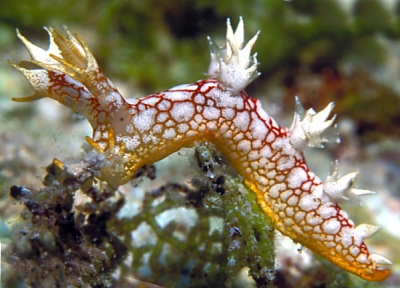
Dear Scott,
Thanks for this. Unfortunately many of the descriptions of species of Bornella appear difficult to interpret. It seems subtleties of ceratal and rhinophore shape are quite important - much more important than general colour pattern.
Best wishes,
Bill Rudman
Bornella stellifer mating
October 9, 2002
From: Nishina Masayoshi
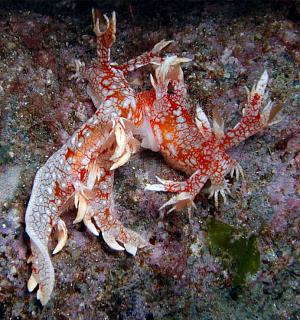
Dear Bill,
Here are some photos of Bornella stellifer mating and and its genital opening.
Date: 4 Aug 2002
Location: Echizen coast, Fukui prif. Japan
Lengh: 30mm
Depth: 6m
Water temp: 27C degree
Photo: M. Nishina
Best Regards,
Nishina Masayoshi
nishina@wips.co.jp
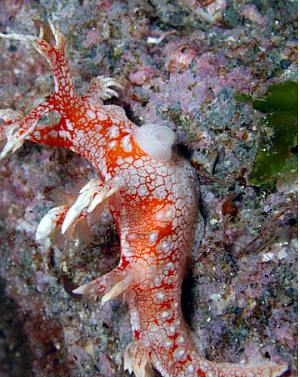
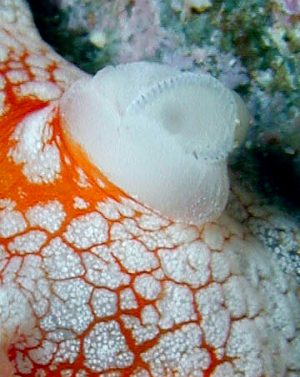
Thanks Nishina,
The close-up of the genital opening shows a ring of hooks around the genital opening. I am not sure what their function is.
Best wishes,
Bill Rudman
Bornella japonica? from Hachijo Is
November 1, 2001
From: Rie Nakano
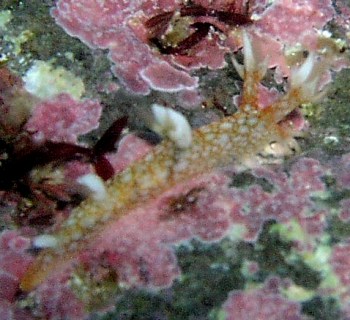
Dear Dr.Rudman
I found this Bornella at the edge of the rocky reef of Hachijo Island, Izu,
Japan, at the end of September, 2001. I dived 4 times and I looked at it each time.
It has 3 pairs of cerata-like structures on each side of its elongate body.
Is this Bornella japonica?
Depth: 8-15m
Length: 5-15mm
Water temperature: 24.6 degrees
Frequency: common in Hachijo
Sincerely,
Rie Nakano
rie@divers.ne.jp
Nakano, R., 2001 (Nov 1) Bornella japonica? from Hachijo Is. [Message in] Sea Slug Forum. Australian Museum, Sydney. Available from http://www.seaslugforum.net/find/5499Dear Rie,
I think this probably is Bornella japonica. I am not sure whether 3 pairs of cerata (dorso-lateral papillae) is important, because that feature may depend on the size of the animal. I think what will be of importance is the shape of the papillae on the rhinophore sheath. Baba describes the posteriormost of the rhinophore sheath papillae to have 3 or 4 secondary papillae, which unfortunately are not so clear on your photo. I suspect also that B. japonica has white cerata without the orange reticulate pattern, but all this can only be confirmed by checking its anatomy
Best wishes,
Bill Rudman
Bornella japonica? from Japan
November 1, 2001
From: Nishina Masayoshi
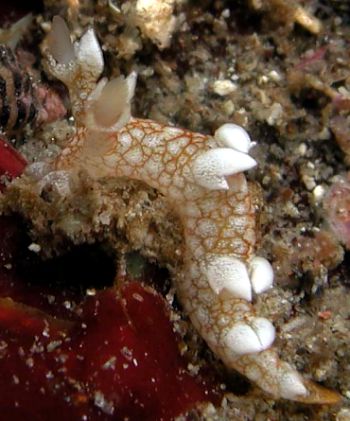
Dear Dr.Rudman,
This animal is generally called Bornella japonica in Hachijo because of the number of the cerata. Baba thinks this is not Bornella stellifer. From my observations, B. stellifer grows quite large (sometimes 50mm or more), but the average size of B. japonica is between 20mm to a maximum of 30mm. This is common in Hachijo Island.
Date: 21 Oct, 2001
Location: Hachijo Island Japan
Depth: 7m
Length: 20mm
Photo by Nishina Chikako
Best Regards,
Nishina Masayoshi
nishina@wips.co.jp
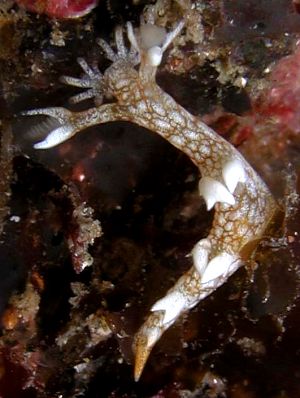
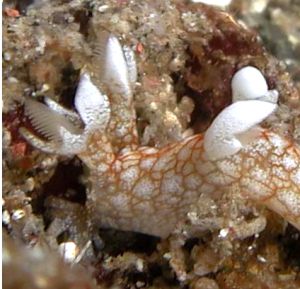
Thanks Nishina,
This looks the same as the photos in Rie Nakano's message but what is interesting is whether it is the same as the photos in your earlier message. I can't see any sign of the secondary papillae on the large posterior rhinophoral papilla in the animal in your present message, but they can be clearly seen in your earlier message. I wonder if these secondary papillae only appear in larger animals?
Best wishes,
Bill Rudman
Bornella japonica? from Japan
September 12, 2001
From: Nishina Masayoshi
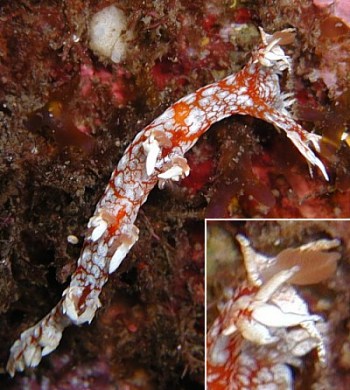
Dear Dr.Rudman,
Here are some photos of the Bornella that I have seen in Japan.
UPPER RIGHT: Echizen coast, 12 Aug 2001. Length is 50mm and it's common in Echizen. Photo: Nishina Masayoshi
LOWER LEFT: Hachijo Island on 18 Dec 2000. Length is 30mm and it's common in Hachijo. Photo: Nishina Masayoshi
LOWER RIGHT: Echizen coast on 12 Aug 2001.
Length is 40mm. Photo: Nishina Chikako
Best Regards,
Nishina Masayoshi
nishina@hpe15.wips.co.jp
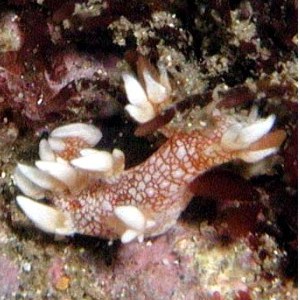
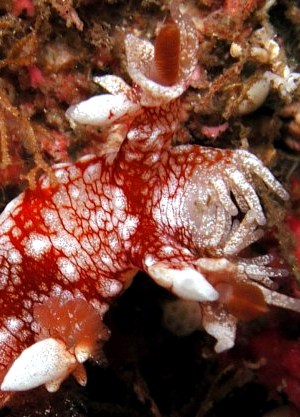
Dear Nishina,
I think this is probably Bornella japonica. I beginning to think that the best distinguishing feature is not three pairs of dorsolateral processes ('cerata'), but their colour. In all the photos I have seen which seem to fit B. japonica, the dorsolateral processes are white and don't have the distinctive subapical orange band found in Bornella stellifer. The rhinophore stalks are also white.
Baba also described secondary papillae on the most posterior papilla on the rhinophore stalk. In your upper right photo [see inset] and lower right, secondary papillae are clearly present. Baba (1949) and Atsushi Ono (1999) both publish pictures of animals that are clearly Bornella stellifer, so it seems there are two very similarly coloured species of Bornella to be found commonly in Japan.
Best wishes,
Bill Rudman
What is Bornella japonica?
September 5, 2001
From: Mike An
Dear Dr. Rudman
I am Korean and I was wondering whether Bornella japonica is a synonym of Bornella stellifer, or a different species? In my web search it looks like they are the same but some Japanese web sites are using this name.
Thank you very much
Best regards
Mike An
kalapati@kornet.net
An, M., 2001 (Sep 5) What is Bornella japonica?. [Message in] Sea Slug Forum. Australian Museum, Sydney. Available from http://www.seaslugforum.net/find/5209Dear Mike,
This is another of the many little puzzles that still need to be sorted out. Have a look at my discussion on the 'differences' between the two species at the top of this page. Basically Dr Baba considered they were the same in colour but differed in a number of external and internal features. For example B. stellifer has about 6 pairs of dorsolateral processes while B. japonica has 3. What we need to see is some more photos of Bornella to see if these differences in similar sized animals are consistent. When you look at websites you should realise that the identifications are not always correct - so photos you have seen identified as B. japonica may in fact be B. stellifer. It doesn't necessarily mean that B. japonica is not a good species, but until we see some good photos which fit Baba's description we cannot be sure. There is one photo I have seen on Japanese website by Hideyuki Takasu which is identified as B. japonica and fits Baba's description in having only 3 pairs of dorso-lateral processes. Unfortunately it is not clear enough to see other details. It is at http://homepage2.nifty.com/nudibranchs/e/umiusi/n_dendronotina/yamato.html
Perhaps you would like to send some information on you and your work for the Participants List.
Best wishes,
Bill Rudman
